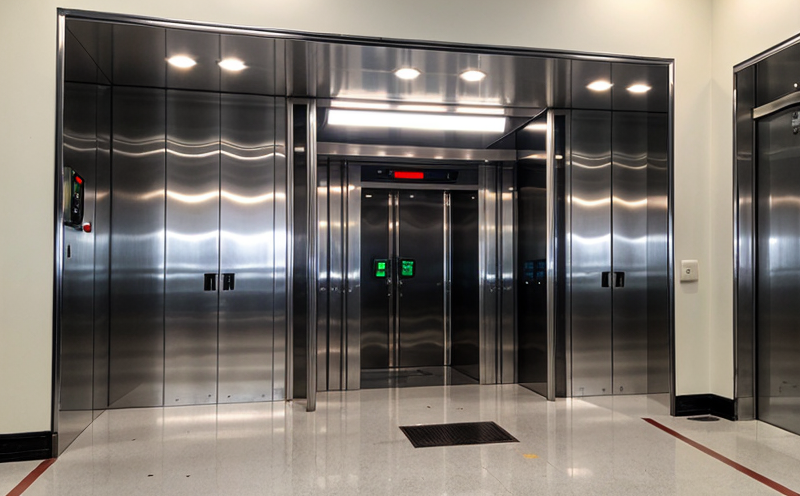Elevator load test inspection
The elevator load test inspection is a critical phase in the maintenance and safety certification process of elevators and escalators. This inspection ensures that these systems can safely handle the designed loads without compromising structural integrity or operational efficiency. The testing aligns with international standards such as ISO 18735, ASTM E2964, EN 81-20, and IEC 62060 to ensure compliance with safety regulations.
The process involves several key steps including the preparation of test samples (in this case, the elevator or escalator system), the selection of appropriate instrumentation for load application and measurement, and the detailed recording of results. The goal is to simulate real-world conditions where the elevators are expected to operate, thereby ensuring reliability and safety.
The testing apparatus used during an elevator load test inspection can vary depending on the specific requirements but typically includes hydraulic or pneumatic loading systems capable of applying precise loads across a range of configurations. These systems ensure that the test can replicate various operational scenarios faced by elevators in their intended use environments.
During the inspection, engineers will apply known weights at specified intervals to simulate different passenger and cargo capacities within the elevator car. The load is gradually increased until it reaches the maximum permissible capacity as defined by local regulations or manufacturer specifications.
| Test Parameter | Description | Acceptance Criteria |
|---|---|---|
| Load Application | The process of applying known weights to simulate passenger and cargo capacity. | Weights must be applied gradually in increments that do not exceed the maximum permissible load for the elevator system. |
| Measurement and Recording | Continuous monitoring of system performance under varying loads. | All data points must be accurately recorded and compared against predetermined acceptance criteria. |
| Elevator Car Movement | The elevator should move smoothly without any signs of malfunction or instability. | No jerky movements, oscillations, or other anomalies are acceptable. |
| Brake Performance | Evaluates the effectiveness and consistency of the braking system under load. | The brake must engage smoothly and effectively at all specified intervals. |
In addition to physical testing, the inspection also involves a thorough review of maintenance records, calibration certificates for safety devices, and compliance with current codes and standards. This comprehensive approach ensures not only that the elevator meets functional requirements but also that it adheres to all relevant safety regulations.
Why It Matters
- Ensures compliance with international standards and local regulations.
- Promotes safe and efficient operation of elevators and escalators in various environments.
- Reduces the risk of accidents by identifying potential issues early on.
- Supports maintenance schedules by highlighting areas requiring attention or replacement.
The importance of elevator load test inspections cannot be overstated. They are essential for maintaining public safety and confidence, which is paramount in high-traffic environments such as commercial buildings, hospitals, and public transport facilities. Regular testing also helps extend the lifecycle of these systems by identifying and addressing issues before they become critical problems.
By adhering to rigorous testing protocols, elevator and escalator operators can demonstrate their commitment to safety and quality, thereby enhancing their reputation and ensuring long-term reliability. This is especially important for organizations responsible for managing large facilities or public spaces where the performance of elevators and escalators directly impacts user experience.
Competitive Advantage and Market Impact
- Enhances brand reputation through proven safety measures.
- Supports compliance with stringent regulatory requirements.
- Promotes continuous improvement in system performance and reliability.
- Reduces operational costs by preventing premature failures and costly repairs.
The ability to consistently perform elevator load test inspections is a significant competitive advantage. It allows companies to differentiate themselves from competitors by offering superior safety features and reliable services. By ensuring that elevators meet the highest standards, organizations can build trust with their clients and customers, which translates into increased business opportunities.
In addition to direct benefits for operators and owners of elevator systems, successful load test inspections also have broader market impacts. They contribute to a safer urban environment, reducing the likelihood of accidents in public spaces. This, in turn, can lead to improved safety standards across industries, fostering innovation and better practices.
Use Cases and Application Examples
- Commercial buildings requiring regular maintenance checks.
- Hospitals where elevator reliability is critical for patient care.
- Malls and shopping centers with high foot traffic.
Elevator load test inspections are widely applicable across various sectors. They are particularly crucial in environments where elevators serve a large number of people frequently, such as office buildings, hotels, and public transport facilities. In these settings, the reliability and safety of elevator systems are paramount, making regular testing an indispensable part of routine maintenance schedules.
| Use Case | Description | Application Example |
|---|---|---|
| Commercial Building Maintenance | Regular inspections to ensure compliance with safety regulations. | An office building with multiple elevators serving thousands of employees daily. |
| Hospital Elevator Reliability | Evaluating elevator performance under conditions that mimic high-traffic scenarios. | A hospital where patient movement and staff turnover require reliable, safe transport. |
| Shopping Center Security | Testing elevators during peak hours to ensure they can handle the maximum load efficiently. | A large shopping center with a busy underground car park. |





